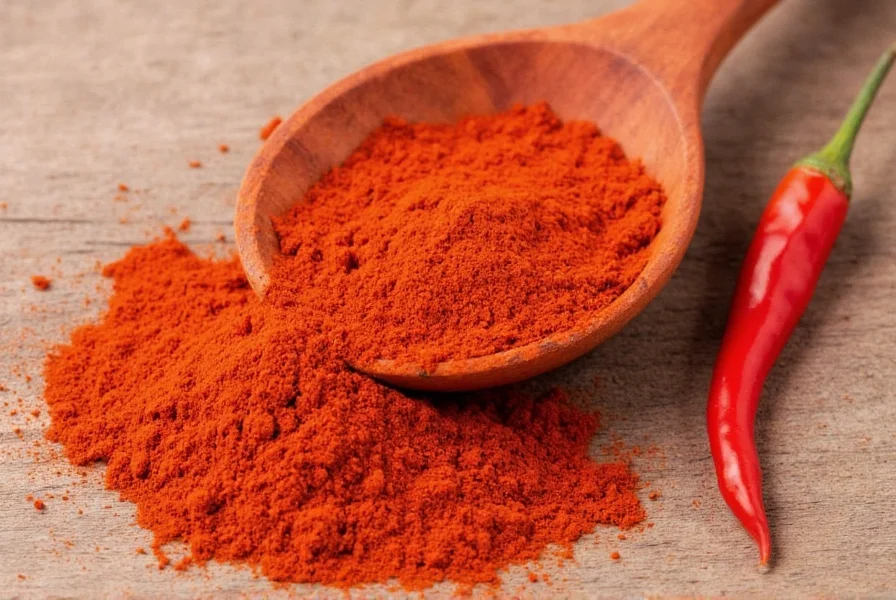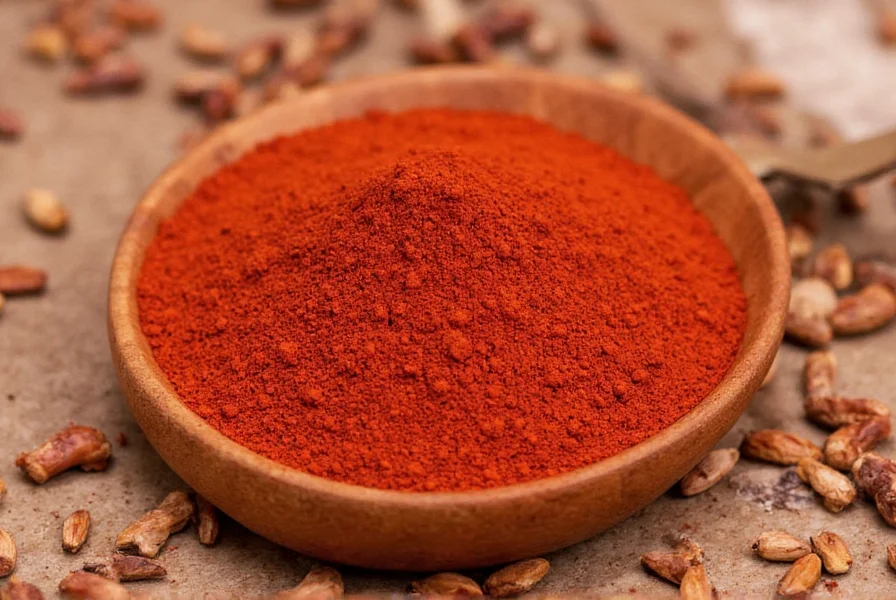Understanding red chili powder begins with recognizing its fundamental role in global cooking traditions. Unlike single-origin spices, this vibrant red seasoning represents a category of ground chili products with distinct regional variations. The most common types derive from cayenne peppers, ancho chilies, or a blend of dried red peppers, each offering unique flavor profiles beyond mere heat.
Composition and Varietal Differences
Not all red chili powders are created equal. The specific peppers used dramatically affect both flavor and heat intensity:
| Pepper Type | Heat Level (SHU) | Flavor Profile | Common Regional Use |
|---|---|---|---|
| Cayenne-based | 30,000-50,000 | Sharp, immediate heat | American hot sauces, Cajun cuisine |
| Ancho (Poblano) | 1,000-2,000 | Smoky, sweet, raisin-like | Mexican mole sauces, adobo |
| Kashmiri | 1,500-2,500 | Mild, vibrant color | Indian curries, tandoori dishes |
| Generic blend | 2,500-8,000 | Balanced heat and earthiness | Global home cooking |
When selecting red chili powder for how to use red chili powder in authentic Mexican cooking, consider that traditional Mexican recipes often specify ancho or guajillo-based powders rather than the cayenne-heavy versions common in American supermarkets. This distinction significantly impacts both flavor authenticity and heat management in dishes.

Culinary Applications Beyond Heat
Chefs value red chili powder not just for its spiciness but for the complex flavor dimension it adds to dishes. Unlike fresh chilies, the drying process concentrates certain compounds while developing new flavor notes through enzymatic reactions. When cooking with red chili powder, remember these professional techniques:
- Bloom in oil - Adding powder to hot oil for 30-60 seconds before incorporating other ingredients releases essential oils and deepens flavor
- Layering technique - Combine with other spices like cumin and paprika for complex flavor profiles in chili or stews
- Marinade component - Works particularly well with proteins due to its ability to penetrate tissues better than fresh chilies
- Color enhancement - Kashmiri-style powders provide vibrant red color without excessive heat in tomato-based sauces
For those exploring how to substitute red chili powder in recipes, understand that direct substitutions often fail because of flavor profile differences. A proper substitution considers both heat level and flavor characteristics. For example, in Indian recipes calling for mild Kashmiri powder, using cayenne would create an unpleasantly hot dish with incorrect flavor notes.
Storage and Freshness Preservation
Ground spices lose potency faster than whole peppers. Proper storage significantly extends red chili powder's shelf life and maintains flavor integrity:
- Store in airtight containers away from light and heat sources
- Refrigeration extends freshness to 18-24 months (vs 6-12 months at room temperature)
- Freezing preserves potency for up to 3 years
- Check freshness by rubbing a small amount between fingers - fresh powder releases aromatic oils
Noticeable flavor degradation occurs when powder loses its vibrant color or develops a musty smell. For optimal results in cooking with red chili powder for maximum flavor impact, replace opened containers every 6-12 months.
Health Considerations and Nutritional Profile
Red chili powder contains capsaicin, the compound responsible for its heat, which has documented health effects. A single tablespoon (6g) typically provides:
- 15-20 calories
- 1-2g dietary fiber
- Significant vitamin A (20-30% of daily value)
- Moderate vitamin E and B6
- Trace minerals including iron and manganese
Research suggests potential benefits from moderate consumption of health benefits of red chili powder consumption, including improved circulation, temporary metabolism boost, and anti-inflammatory properties. However, excessive consumption may cause gastrointestinal discomfort in sensitive individuals. Those with GERD or ulcers should consult healthcare providers about appropriate intake levels.

Creating Homemade Red Chili Powder
For superior flavor control, making your own red chili powder offers distinct advantages over store-bought versions. Follow this professional method:
- Select fully ripe red chilies (ancho, cayenne, or specialty varieties)
- Dry thoroughly using a food dehydrator (135°F/57°C for 12-24 hours) or oven method
- Remove stems and seeds (seeds increase heat but reduce shelf life)
- Grind in small batches using a dedicated spice grinder
- Sift through fine mesh to remove fibrous material
- Store immediately in airtight container
This process for how to make authentic red chili powder at home preserves more volatile flavor compounds than commercial processing. For complex flavor profiles, blend different dried chilies in ratios like 60% ancho, 30% guajillo, and 10% cayenne.
Common Misconceptions Clarified
Several persistent myths surround red chili powder that affect proper usage:
- Misconception: All red chili powders are interchangeable
Reality: Flavor and heat profiles vary significantly between regional varieties - Misconception: Red chili powder is the same as cayenne powder
Reality: Cayenne is one type of red chili powder; many blends contain multiple pepper varieties - Misconception: Spiciness indicates quality
Reality: Proper heat level depends on the dish; many authentic recipes use mild varieties for color and flavor
Understanding these distinctions proves essential when following recipes that specify difference between red chili powder and cayenne pepper for authentic results.
Frequently Asked Questions
What's the difference between red chili powder and paprika?
Red chili powder typically contains hotter pepper varieties and has a more pronounced heat (2,500-8,000 Scoville units), while paprika ranges from sweet and mild (0-500 SHU) to hot varieties (5,000-30,000 SHU). Authentic Hungarian paprika emphasizes flavor complexity over heat, whereas red chili powder generally provides noticeable spiciness. For substituting red chili powder for paprika in recipes, use half the amount of chili powder and add sweet paprika to balance heat.
Can red chili powder go bad?
While red chili powder doesn't spoil in the traditional sense, it loses potency and flavor over time. Properly stored in an airtight container away from light and heat, it maintains optimal flavor for 6-12 months. Signs of degradation include faded color, musty smell, or lack of aroma when rubbed between fingers. For how to tell if red chili powder is still good, perform a small taste test - stale powder tastes flat and one-dimensional compared to fresh.
Is red chili powder gluten-free?
Pure red chili powder made from ground dried chilies is naturally gluten-free. However, some commercial blends may contain anti-caking agents or be processed in facilities that handle gluten-containing products. For those with celiac disease or severe gluten sensitivity seeking gluten-free red chili powder brands, look for certified gluten-free labels and check ingredient lists for potential additives. Making your own from whole dried chilies guarantees gluten-free status.
How does red chili powder affect digestion?
Red chili powder stimulates digestive enzymes and may improve digestion in moderate amounts. However, excessive consumption can cause heartburn, stomach irritation, or diarrhea in sensitive individuals. The capsaicin content triggers temporary increased metabolism but may exacerbate conditions like GERD or ulcers. For managing digestive effects of red chili powder, start with small amounts and pair with dairy or starchy foods which help neutralize capsaicin's effects.











 浙公网安备
33010002000092号
浙公网安备
33010002000092号 浙B2-20120091-4
浙B2-20120091-4